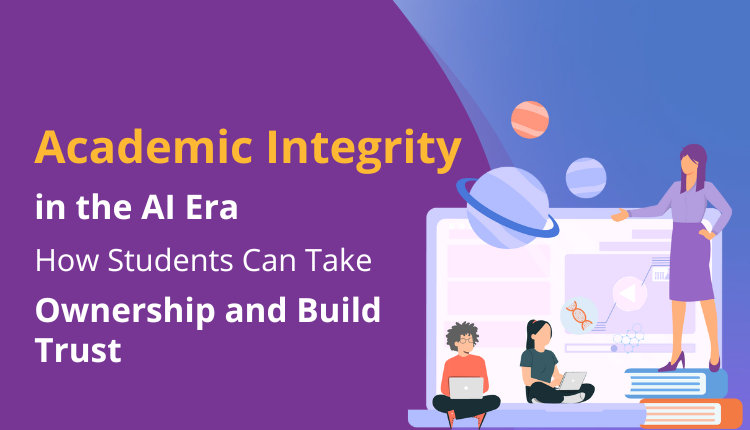Academic Integrity in the AI Era: How Students Can Take Ownership and Build Trust

Introduction: Moving Beyond AI Detection to Student Responsibility
In today’s digital age, academic integrity has never been more complex. With the rapid advancement of AI tools and the increased accessibility of online resources, students and educators face new challenges in maintaining ethical standards in academic work. However, the focus has shifted from education to policing, with inaccurate AI detection creating stress for faculty and conflicts between students and educators.
The solution lies not in avoiding AI, but in building transparency and helping students take explicit ownership of their AI use while reducing faculty burden. By shifting from reactive detection to proactive learning outcomes, institutions can restore the clarity of the pre-ChatGPT era while embracing responsible AI use.
What Is Academic Integrity?
At its core, academic integrity refers to upholding ethical standards in academic work. It involves completing assignments honestly, fairly, and with transparent disclosure of any AI assistance used. The main components of academic integrity include avoiding plagiarism, properly citing sources, conducting independent research and work, and taking explicit ownership of AI contributions.
In the AI era, academic integrity also means building AI literacy and understanding how to use AI tools responsibly rather than trying to hide their use. This proactive approach builds trust between students and educators while ensuring that academic achievements reflect genuine effort and learning.
Why Is Academic Integrity Important?
The importance of academic integrity is multifaceted. However, traditional approaches focused on catching violations often create adversarial relationships rather than promoting learning. Fair grading requires transparent assessment methods that focus on learning outcomes rather than unreliable AI detection.
Building trust requires moving beyond inaccurate AI detection tools that often damage relationships through false accusations. Instead, transparency-first approaches restore trust by eliminating conflicts and focusing on education. Academic integrity should motivate students to develop responsible AI literacy while taking ownership of their learning process.
The Crisis of Inaccurate AI Detection and Student Anxiety
The current challenge isn’t just traditional violations, but the crisis created by inaccurate AI content detectors. Students now face anxiety about false accusations, while faculty experience stress from unreliable detection tools.
The real issue is that students often don’t know how to use AI responsibly, leading to misuse rather than intentional cheating. Without proper guidance, students may use AI incorrectly, not because they want to cheat, but because they lack clear boundaries and AI literacy.
The solution requires proactive approaches that guide students toward responsible AI use while reducing conflicts and building trust through transparency.
How Students Can Take Ownership of Their AI Use
Achieving academic integrity in the AI era requires transparency, responsibility, and explicit ownership of AI assistance. Students need structured guidance that helps them review their AI use and take responsibility for their submissions.
This includes understanding how to properly disclose AI assistance and demonstrate genuine learning despite AI support. Students should focus on building AI literacy and using AI tools to enhance rather than replace their learning.
This approach builds confidence in submitting assignments without fear of false accusations while ensuring authentic academic achievement. The key is learning to use AI transparently and ethically, with clear boundaries and proper disclosure.
Through structured review processes, students can verify their AI contributions and take explicit ownership of their work. This proactive approach helps students understand the boundaries of responsible AI use while building trust with educators.
DocuMark: Empowering Students Through Transparency and Ownership
Rather than relying on inaccurate AI detection that creates stress and conflicts, DocuMark offers a revolutionary transparency-first approach. DocuMark is an academic integrity platform that shifts focus from detection to learning outcomes, helping students take responsibility for their AI use while reducing faculty stress.
Through a structured review process, DocuMark guides students to verify their AI contributions and take explicit ownership of their work. This motivational and proactive approach builds AI literacy while ensuring transparent, authentic submissions.
Students report feeling more confident about their submissions, knowing they’ve properly disclosed their AI use and demonstrated genuine understanding of their work.
Student testimonials include:
- “I was using AI incorrectly until DocuMark guided me. Now I’m confident submitting my assignments without fear!”
- “DocuMark showed me how to properly incorporate AI tools. I understand the boundaries and feel honest about my work.”
For faculty, DocuMark eliminates the burden of AI detection by providing verified submission reports, allowing educators to focus on teaching rather than policing. This approach restores the clarity and trust of the pre-ChatGPT era while embracing today’s technology.
For administrators, DocuMark provides clear data and insights to reinforce institutional AI policies while reducing academic integrity violations and ensuring consistent, fair grading across all submissions.
Conclusion: Building Trust and Responsibility in the AI Era
Academic integrity in the AI era requires moving beyond inaccurate detection to transparency-first approaches that build trust and reduce conflicts. By taking explicit ownership of AI use through structured review processes, students can build confidence, develop AI literacy, and maintain authentic academic achievements.
DocuMark represents a paradigm shift that empowers students to take responsibility while reducing faculty stress and building institutional trust. This proactive approach creates a culture of transparency and accountability that benefits all stakeholders.
By adopting DocuMark’s transparency-first approach, institutions can lead the way in responsible AI adoption—fostering trust, reducing faculty workload, and guiding students toward ethical AI use while maintaining the highest standards of academic integrity.
